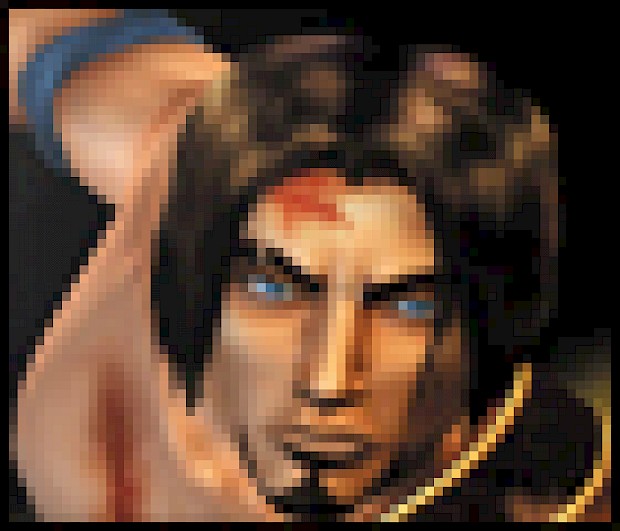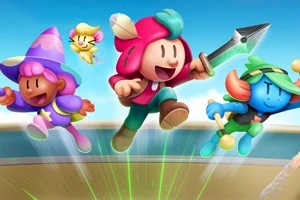Feature: The Prince And I

Posted 15 Sep 2005 at 11:43 by guest

For many of us who grew up during the 16-bit era, Prince of Persia occupies a special place. The style, the swordfights, and the groundbreaking animation from Jordan Mechner all came together in a truly classic computer game. In the run-up to 2003’s Prince of Persia: The Sands of Time many fans (including this one!) were somewhat sceptical: the previous attempt to convert the Prince into 3D was a dismal failure. But The Sands of Time astounded gamers and critics alike, with its beautifully crafted atmosphere, precise gameplay mix of platforms, puzzles and combat, and character-driven story. Looking back on last year’s sequel, Prince of Persia: Warrior Within, the disappointment felt by gamers is still fresh in their memories.
The changes to the style and substance of the series were clear from the outset. Gone were the fantastic Arabian Nights setting, the Middle Eastern palace, courtyards and gardens. Gone was the superb score and ambience. Gone were the central characters that we loved – the Prince changed beyond recognition, Farah completely absent. More importantly, the finely tuned gameplay was fatally imbalanced by the neglect of the platforms and puzzles at the expense of (still) weak combat. The end result? Warrior Within was one of the most grating and tedious gaming experiences of last year, a game saddled with an unlovable, unrecognisable lead character, complete with snarling accent; a dreadful, totally misplaced nu-metal score; a gameplay model ruined by a lack of quality platforming and concentration on gratuitous gore and violence, leading to some seemingly endless combat sequences that tested the player’s patience rather than skill. The final insult was that this Prince of Persia title was not set in anything resembling ancient Persia.
All of which begs the question: why? Why was this critically acclaimed game distorted into something that bears no relation to its own title or series? The disappointing sales for The Sands of Time are undoubtedly the main reason. Ubisoft’s expectations were dashed, as the game was buried under a ton of larger titles, big-name franchises and licences, and sold fewer than 1 million copies in the Christmas rush. In retrospect, it was perhaps not the best tactic for Ubisoft to re-launch a long-dormant franchise during the games industry’s busiest time of the year. Sales for Warrior Within in late 2004 were an improvement, and while this may be partly due to Ubisoft building on the previous game’s cult status, its success is most likely due to the new “dark” and “mature” style.
As IGN reflected in January 2004, “It could also be that Ubisoft's title lacked the right theme to appeal to a broader audience.” This is a considerable understatement. The Sands of Time failed utterly to reach mainstream gamers. And, in this writer’s opinion, it was the Middle Eastern theme of the game more than anything else that ensured that failure.
Admittedly, it is difficult to “prove” this in any sense. But the very fact of the series’ artistic overhaul shows that there was something fundamental to The Sands of Time that had to be jettisoned. Taking in an adventure that follows a marauding army in India and a return to the palace of Azad (now in modern day Iran), featuring a Middle Eastern hero with upper-class accent and sensibilities, and a musical score and artistic style evoking ancient Persia, is it any surprise that The Sands of Time was a commercial flop? The year 2003 was not exactly a great period for Western relations with the Middle East either, and the sensitivity of the general public to ongoing affairs was always present.
In response, the developers attempted to mainstream the Prince in Warrior Within, creating a game that looks like an emo rock band’s fantasy: and, as mentioned above, creating a game that is not in any way clearly set in Persia. Yet to call this “mainstream” is not entirely accurate: violence and a contemporary rock soundtrack are hardly prerequisites for a successful game. This is not a poor reflection on Ubisoft’s part – but rather on the part of the gaming community. For it could be said that this Persian hero was anathema to many gamers in North America and Europe: this is a sad indication of today’s social and political climate.
Computer games have a long history of drawing on ancient civilisations and eras as settings. Ancient Japan, Greece and Rome can be found in any number of titles. But the central heroes and characters of today’s games are overwhelmingly white males: something else that has a long history in games. The outcry of America’s Haitian community with regard to Grand Theft Auto: Vice City is only one example of reaction to this underlying, unspoken racism (or at least narrow-mindedness) in the games industry. Consider also the recent demand from certain sections of the gaming community for a patch to Grand Theft Auto: San Andreas to make lead character CJ white. Older gamers may remember Lucasarts classic The Secret of Monkey Island from 1990, an atmospheric point-and-click pirate adventure set “deep in the Caribbean” – and featuring precisely one black character.
Indeed, female leads, black and non-white heroes are in short supply. Middle Eastern characters are non-existent, unless they’re being depicted as the villains in counter-terrorist titles. Of course, this is not exclusive to the games industry. The white male hero archetype, for example, is predominant in mainstream cinema and television. Black and female characters are still portrayed as stereotypes; gay characters suffer the same fate. It appears that audiences and consumers accept these portrayals, something that does not reflect well on society. Whether in games or other forms of popular culture, white lead characters are the norm, an unfortunate fact of life when considering the heroic Prince. Yet his incarnation in The Sands of Time was encouraging, and the young games industry is still learning, evolving, and including different heroes and characters.
But there appears to be no place for the Prince as we knew him – the next title, Kindred Blades, is an attempt to bring back the fans of The Sands of Time through its setting in Babylon, yet it retains the dark, moody lead character and grim violence from Warrior Within. It is a dreadful shame, as this likable hero was a refreshing change from the kind of thing that he eventually became. While gaming may be on the verge of becoming mainstream, it is to be hoped that the narrow-mindedness that characterises so much of the industry is left behind. The games community cannot afford to let characters like the Prince to be buried by the sands.
Nick Bennett
[email protected]






















